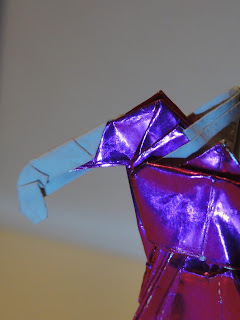Today, I folded a shield for my Orirobo 117 out of a green sheet of 4 1/2 inch Fold'ems paper. Called a Cosmic Shuriken Guard in the book, it is a slightly modified shuriken model and is listed as one of the signature weapons of 117. It took about twenty minutes to fold.
The folds in the back allow for any of the robots in the book to attach it to their arms.
 |
| Cosmic Shuriken Shield... |
 |
| locked! |
 |
| Oh yeah! Check out all his majesty. |
The balance of the model changes when he holds the shield. Fortunately, it provides a third point of contact with the ground if you angle it right.
All the accessories in the book are supposed to be crafted from a piece of paper a forth the size of whatever you used to make the robot. Consequently, the guard I made today is a bit on the big side. It's a shield though so it just means it protects even more.
Feeling an accessory for one of the robots wasn't enough to necessitate its own blog post, I also made Super Orirobo 126B. He took several hours to complete and was not without a few problems. Chief among them being the new paper I was using, a duel colored piece of
Tuttle origami paper, is too thick and weak for the heavy folds in the model. At 8 1/4 inches, it's also a bit bigger than 117, but not noticeably so.
As you can see, quite a bit of color was worn off the oldest and deepest folds. Still, the overall model is very cool and I feel the dual colors help it stand out a bit more than 117 did.
Here's a view from behind. My folds were quite a bit more accurate this time and the layers folded quite nicely.
I'm slightly irked that one of the shoulder spikes failed to fold as sharply as it should have. It causes the whole thing to feel a bit unbalanced despite the precise folding of the body.
The legs were also a bit of a problem due to some thick folds required around the torso. Still, it stands easier than the other two robot models, so I can't complain.
The biggest problem I had was with the folds that are hidden by the upper torso. I'm not sure if it was planned this way, but it's a really good thing you can't see the point where all those hidden layers meet because there is a gigantic hole it the paper that was worn through from all the stress put on it. Again, I feel this is a shortcoming of the paper and not the design.
Super Orirobo 126B is the third and last generation of this line of robots. His stats are all very high and given that his signature moves are punches and kicks, it would seem he mostly relies on bute strength to win his battles. He also utilizes the shoulder spikes for combat. A holdover from the arm cutters of the last generation perhaps.
Height comparison. They all have a certain flair despite their construction processes being quite similar. Of the three, I think I like 126B the most in theory. In practice, 117 wins by virtue of being the most stable and best looking wear and tear wise. Maybe I'll try folding another Super Orirobo with some of my other paper.
 |
| Suit up. |
 |
| Weapons training. |
 |
| Max armaments! |
Hooray for 100 posts!



















































